See also :
Compare with Hybrid IKs
Moki II preview
Aquaglide Chelan 155
Advanced Elements AirFusion
In a line
Good-looking, roomy and high-pressure package that’s as wide as a packraft but turns like a tanker.


everything in the bag except a cheap paddle
Removable floor for easier rinsing and drying
Adjustable footrest tubes PLUS paddle holders
Massive 12-inch tubes mean payload is probably as big as claimed
Good colours and design, as IKs go
3-YEAR WARRANTY
Seen discounted from £999 to £725 August 2022

USUAL ‘SHELL & BLADDER’ DRYING ISSUES
Nearly a metre wide
Thin, hard seat bases
Too bulky and heavy for easy travelling
Massive 12-inch tubes mean not that much room inside at either end
Error-laden Kokopelli online specs [at time of review]

What They Say
The innovative [2020] Moki II two-person inflatable kayak offers an option removable spraydeck and sprayskirt. Giving you even more paddling options, seamlessly convert from a one-person to a two-person boat by simply adjusting the seats. Weighing 53lbs, the Moki II features a 2 person spraydeck removable spraydeck and 2 Alpine Lake Sprayskirts, high pressure rigid drop-stitch floor, user friendly push-push valves, 9” removable tracking fin and packs down seamlessly to fit into the included full-size premium carry bag. It’s ideal for flat open waters, touring, and ocean paddling.
Out of the bag
Your ‘premium carry bag’ is a giant roller suitcase with a rather optimistic backpack harness which, on this unused boat, the pulling handle had already ripped away. The bag weighs 27 kilos with everything in it and once you start unpacking, stuff just keeps coming out: hull, floor, pump, footrest, tandem deck, spray skirts and coaming rods, a skeg and a repair kit.
Weight: 24kg (53lbs) • Full kit in bag 27kg (59.5lbs); boat with seats 21.5kg (47.4lbs)
Length: 4.3m (14 feet)
Width: 91cm (36″) • undecked 99cm (39″); with deck 96.5cm (38″)
Sidetube ø: 21.8cm (8.6″) • 30.5cm (12″)
Payload: 272kg (600lbs)
Pressures: Sides 0.17bar (2.5psi); DS floor 0.27bar; (4 psi) • Set-up leaflet says: sides 0.27bar (3-4psi), floor 0.69bar (8-10psi)
Construction: 840D nylon inner/top; PVC tube undersides and floor skin; PVC bladders; 1000D removable PVC DS floor.
Price: U$ 999; UK £950

Based purely on online photos and specs, my Moki II preview a few months ago brought up anomalies with the boat width. Getting an actual boat allowed some of these specs to be verified in red, above. Some are out by 50% and the claimed packed size of 29″ x 14″ x 13″ is more like twice as wide. You can tell from the rambling, repetitive ‘What they Say…’ quoted from the same page above that it was hastily put together. That’s a shame as from first appearances, this cannot be said of the boat itself. And from the exceedingly low psi figures quoted, it’s not like it’s the usual ‘tactical exaggeration’ to make the Moki II look better than it is. You’d hope someone at Kokopelli might find ten minutes to correct the online specs.

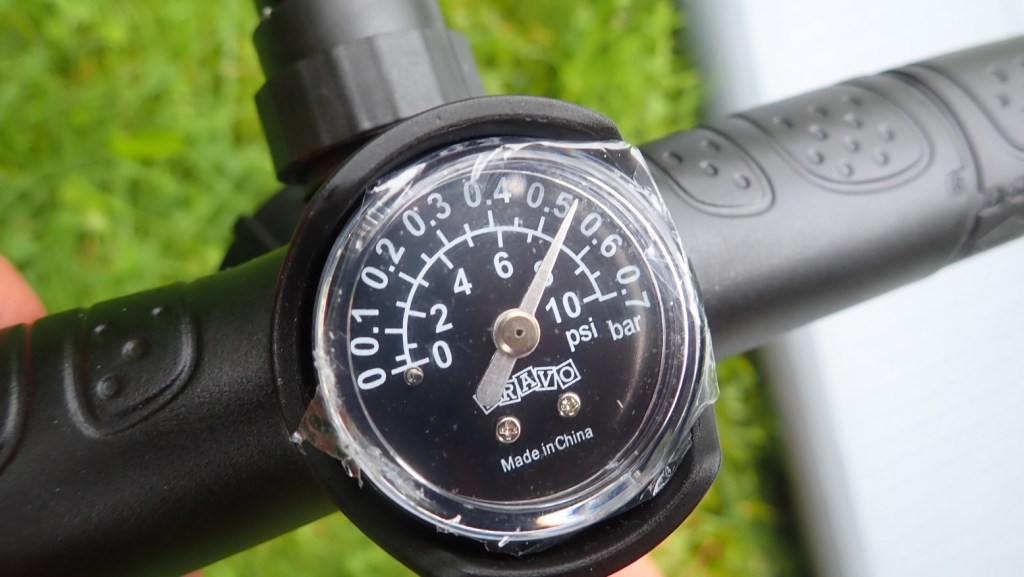
Enough moaning: time to man the pump and straight away I really liked the compact black Nano barrel pump. The feet clip down, T-handle extensions screw on, there’s a lever to switch from two-way pumping (up and down) to down-stroke-only (less effort), plus a pressure gauge on top and a suction port for full deflating. It’s one of the best compact IK pumps I’ve seen. Kokopelli don’t list it but if you can find it online (the Aqua Marina looks similar), get one.
I was easily able to inflate the DS floor to 8-10psi on the up-and-down setting but later, topping up on the water with the pump on the boat’s DS floor, found one-way easier to do one-handed. Being a small volume pump of about a litre, the 12-inch side tubes took at least 100 strokes to reach 3-4psi. The inflated boat now looks pretty massive so the 270-kilo payload rating does not look like a mistake or exaggeration.

It was here I realised I should have RTFM, but then again I like to follow my intuition and see if it pans out. I had to deflate the sides to allow the pumped-up floor to centre correctly. Unlike with Full DS IKs, the Moki’s round side tubes hold the floor firmly in place without the need for any clamps or tabs.


The top/inner parts of the hull (mostly yellow, grey at the back) are woven 840-D nylon, possibly backed with a PU coating for waterproofness, and certainly with a water repelling DWR coating on the outside. This stops the fabric ‘wetting-out’, although from jackets and tents I know DWR needs reproofing and curing with an iron once in a while. Without it, the nylon will soak up water and take forever to dry. Full PVC (or rubber) tubes are better in this respect, but nylon makes it easy/cheap to sew on fittings like the velcro paddle-holders, footrest daisy chains, carry handles and D-rings for the seat backs, plus short access zips at each end to get to the PVC bladders, if needed.

The yellow sides are stitched to the grey PVC underside of the tubes and the PVC floor sheet is heat welded to the tubes: all very neatly done. This is the nifty thing with PVC: surgically clean heat welds rather than the laborious, messy and vapourous glue needed by rubber-based IKs.
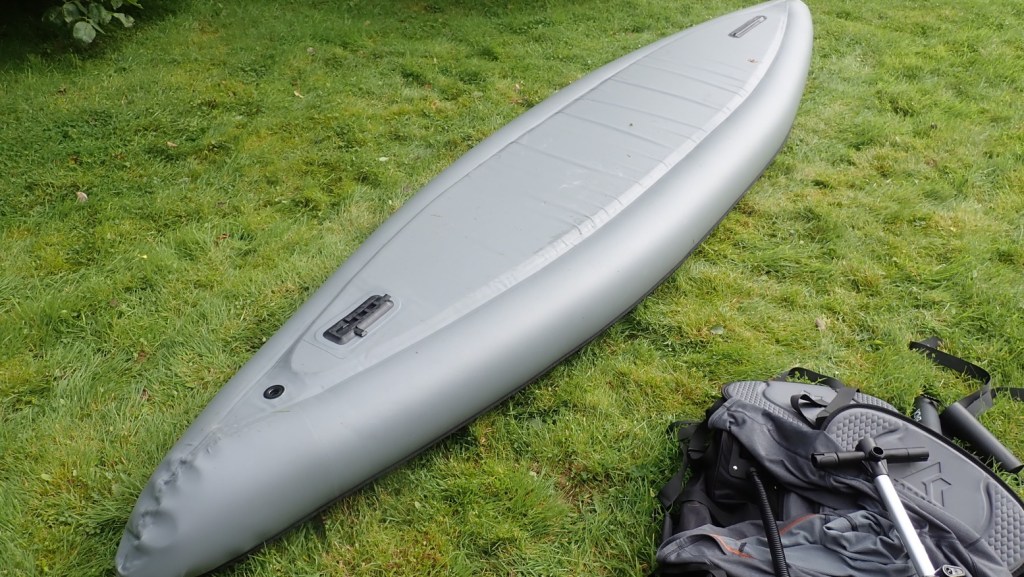
Apart from the crinkles at the bow and stern (which have thin plastic shells inside to help tidy the form), it’s all a very neat job. On the underside is the slot-in mount for the tracking fin (skeg), a stern drain plug accessible via a zip from the inside, and up front a shallow keel strip: more about that later.
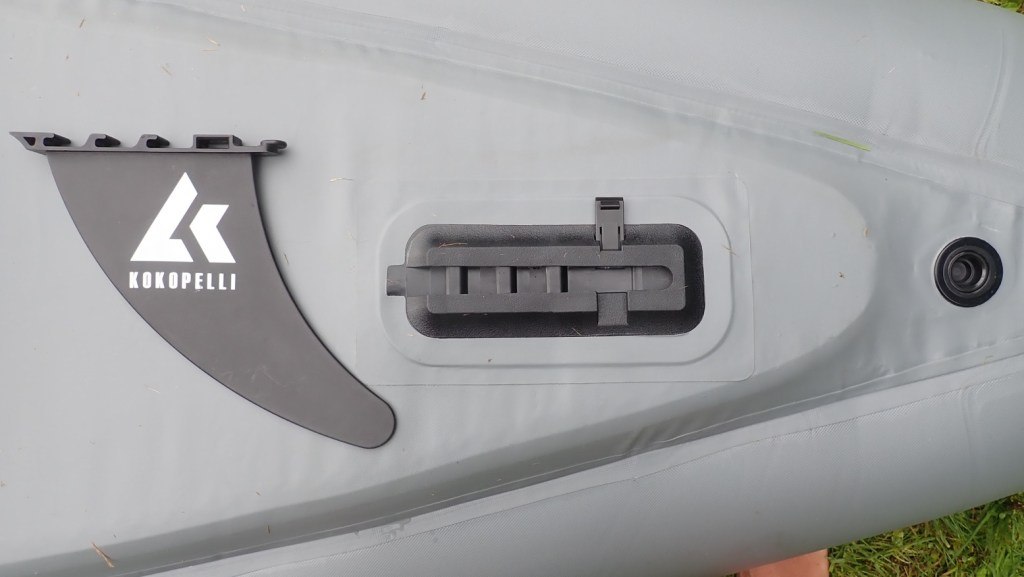

Next are seats and footrests – no loose item escapes ‘Kokopelli’ branding. The firm EVA foam seats are common on many IKs these days, but stiffness is best suited to a backrest, not a 4cm-thick seat base which, sat on a firm DS floor may be too low for a an efficient paddling stance and too thin for all-day comfort. It’s something easily fixed with an inflatable cushion like a packraft seat base. More seat ideas here. The generous width of the Moki II means raising the seat is unlikely to affect stability.
The seat bases adhere to velcro strips sewn then welded to the DS floor. It’s an easy way of doing it while the velcro lasts. I found when sat in the front I was right at the end of the velcro; another foot would be handy, then you could fit a third kiddy seat in there.
A non weight-bearing backrest is a better use of stiff foam. They’re tensioned from the front and rear to stay upright; a floppy seat base is very annoying when getting in is awkward. Wide adjustment helps you fine tune them and on the back you get a handy zipped pocket and bottle holder.

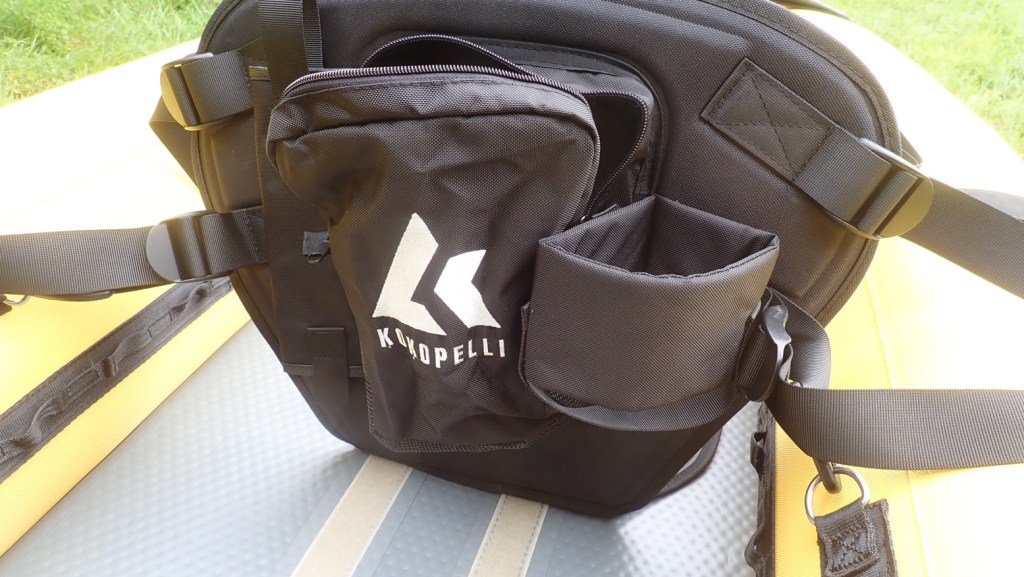
The footrests are thick foam tubes commonly found on cheaper Sevys the like, and are threaded with a strap which clips to daisy chain loops stitched to the hull sides. Unused loops could also be used for securing gear because mounting anything under the bungie laces at either end of the boat is not such a good idea for forward visibility, accessibility, security, dryness and windage. These bungies are more useful as a quick way to stash a paddle.


Set up like this, the boat is a brawny 39 inches wide (99cm) but adding the zip-on deck and coaming rods pulls the boat in to 38 inches. Including a deck is a nice touch, so is the option to use it. On IKs I find them rather less useful than they seem: they make access, loading and getting in and out more awkward and if you’re worried about getting wet, paddling may not be for you. Once you pull on the also-included spray skirts you will be snugly encased in your Moki and ready to hit the rapids or surf. I’d have sooner had these items offered as optional extras, as most others do, and seen a cheaper boat.
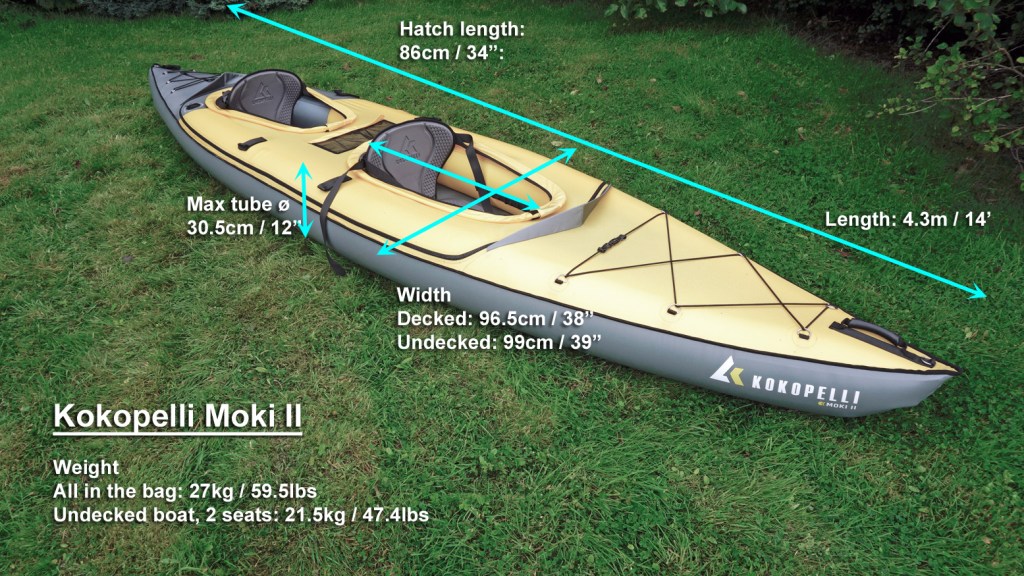
On the Water
Initially the Moki 2 looked huge, but it’s actually a foot shorter than my Seawave and so didn’t look too out of place on the car roof. We set off in search of a accessible fresh water and after a while found a trio of co-joined lochs off the B8073 feeding the steam which soon drops into Tobermory.


Topping up the Moki II on the water (all inflatables benefit from a top-up once put into cold water), the barrel pump stood on the firm floor and with one handed, one-way down-pumping, it was easy to attain the 4/10psi (0.27/0.69 bar) maximum pressures. This is Scotland in late August so there was no risk of the blazing sun bursting out and ripping the boat asunder.


I set off without the tracking in and, as expected, found my front load on the keel strip make for tricky tracking. The deck was easy to manage but to me is a nuisance. It zipped off in seconds and got left on the bank.

It may be a metre-wide bladder boat but it’s still a kayak and so feels great once gliding out over the water. The Moki II needs a bit more propulsion to what I’m used to, but the mattress-like stability will be reassuring to beginners.

It was only flat water so the apparent stiffness from the DS floor and high-psi side tubes didn’t feel any greater than my 2.5/4psi Seawave. Unless you’re braced properly to the boat (the problem with just about all IKs) there is little actual benefit to be had in paddling efficiency, just the longer glide. In rougher water you imagine it might come down with a slap as it drops into wave troughs. According to the GPS the two of us could sustain about 5-6kph which is pretty good, but an all-out burst only recorded 8.4kph (5.2mph) when I’ve got 10kph alone in similarly long but less-wide IKs.
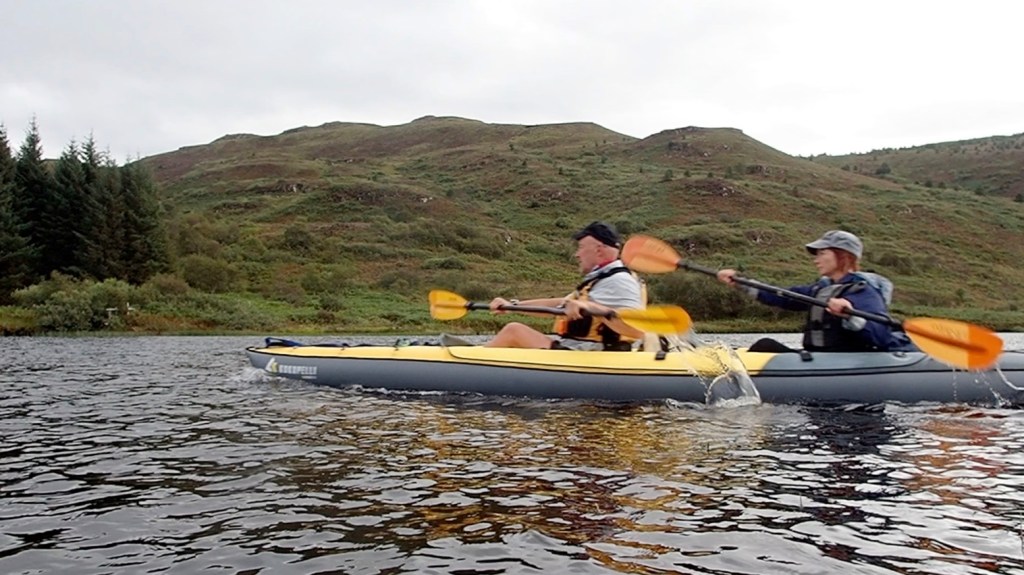
It soon became apparent that the Moki II tracks rather too well; something I’ve heard of other DS IKs with frontal keels or fins. Turning it even a few degrees was a huge effort. In the end we had to resort to digging the paddles in and drawing them forward to force the boat round. The problem with this technique is it kills momentum, though it’s possible you’d get used to working the boat in a less drastic manner.

You also notice that two-up there’s not much room for gear because the side tubes are so fat. The last foot or two at each end can’t be used much – again a common story with big-tubed IKs, if not any pointy ended kayak.
We scooted through the reeds which whined like sirens against the PVC hull, then passed under a rickety wooden bridge to the middle loch. This led to another reedy strait into the last loch above Tobermory and a view towards what was probably the 528-m flat cone of Ben Hiant over on Ardnamurchan. The sun came out, the sun went in and eventually the little camera’s batteries died after too much videoing.
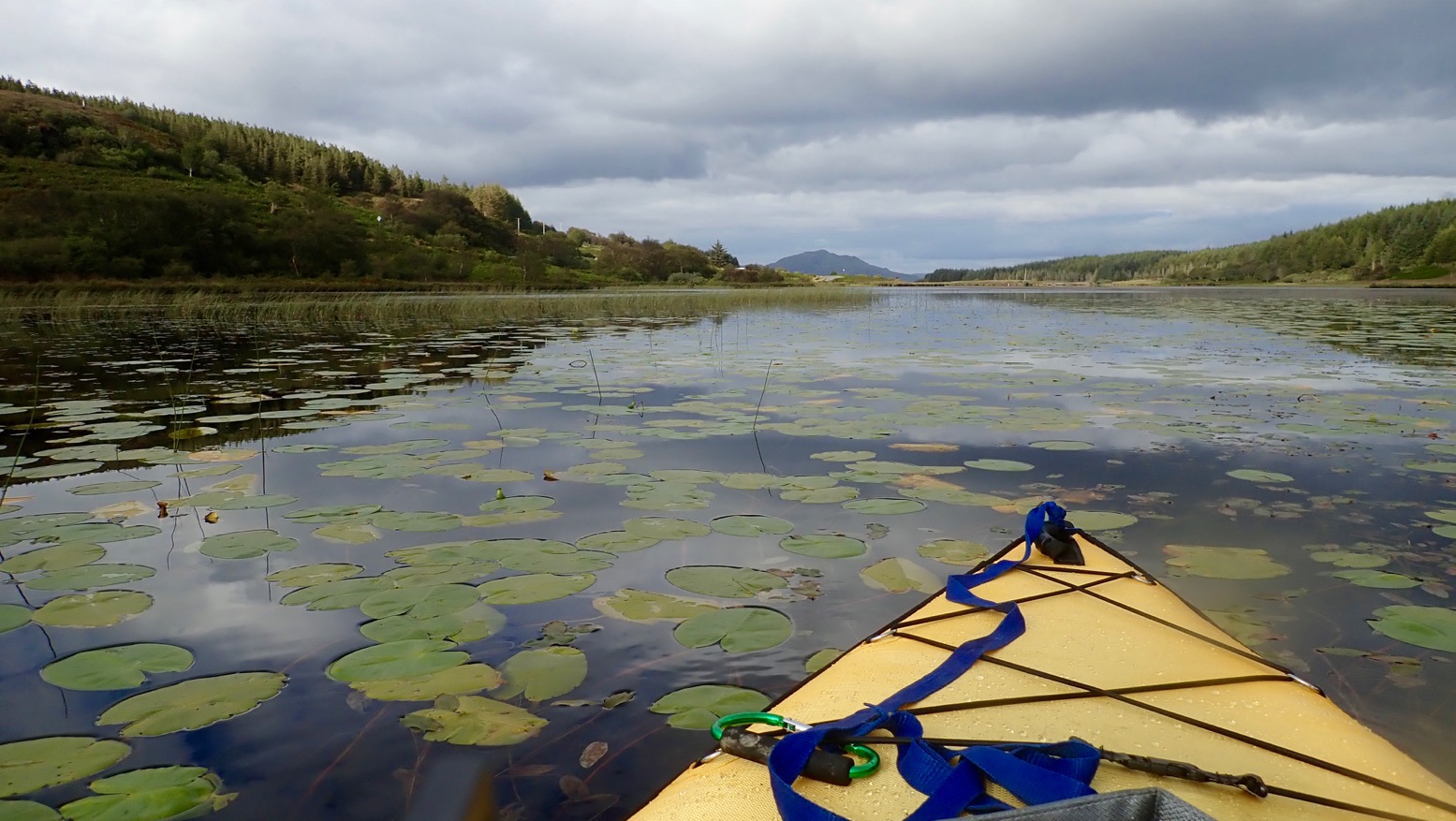
Next evening promised to be sunny too, but it wasn’t. I wanted to explore the slim sea loch at Dervaig and had timed our put-in at least an hour after low tide so if the narrows leading out to sea turned into the Falls of Lora we’d get swept back in, not out into the Minch. The 10-minute portage over the tidal slime raised some grumbles from the crew not used to lugging 25-odd kilos of packboat across the mire.
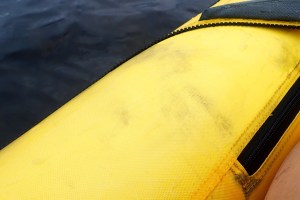
I managed to wade through some shoe-sucking, shin-deep sludge to reach enough water to float on without the 9-inch fin, then paddled over to somewhere deeper where the crew could hop in and the fin get fitted. First thing I’d do with this boat is cut that fin down. Another issue I noted is that the woven yellow hull fabric may shed water readily, but picks up any smeared muck rather well. More cleaning before returning to the rental place tomorrow.
We headed out towards the narrows in the grim, grey light, feeling altogether uninspired.
‘The tide is going out, we’re all going to drown!’
‘It’s just the breeze over the surface. There are no times for Dervaig but Calgary to the south and Tobermory to the north were at low water nearly 2 hours ago.’
‘I’m telling you, the tide is going out!’
As we neared the malignant, 80-metre wide cleft on Loch An Chumhainn, ominous whorls bubbled up from the silty abyss and on entering the chasm the flow was clearly on the ebb.
‘I told you it was going out. Idiot!’
‘You watch, any minute now it’ll miraculously reverse, like it did on the Adur last week.’
I know tide times are only predictions but this was indeed odd and yes, I checked against BST/GMT and checked again I’d not misread 16.46 as 6.46pm. The tide should have been coming in for 90 minutes. I’d expect a constricted sea loch like this one to be a slow to fill and fast to drain, like Chichester Harbour in Hampshire. But that is a massive pool; Loch Chum is tiny.
We were now being swept down the Narrows of Chum at a slow walking pace and it was time to make a decision. Carrying on would take us two clicks to a jetty at Criog which we’d recce’d that morning on the bikes. That would be a long walk back to the car, so we dug in for a handbrake turn and escaped from the imminent maelstrom at a reassuring clip.
I recently read a review of a Sea Eagle with a frontal keel lobe which the owner said made the boat very hard to control against a current (as you’d expect). With the Moki II we had no such issues. There is not so much to explore in the inner bay but the tide would now be even lower with even more seaweed-draped, ankle-twisting shite to traipse over before getting onto to the ankle-twisting, midge-infested peat bogs above.
Wading in after the fin started grounding, in the end we found an easier take-out, followed by a 10-minute portage back to the car. I need to ask a Dervagian about these tides.
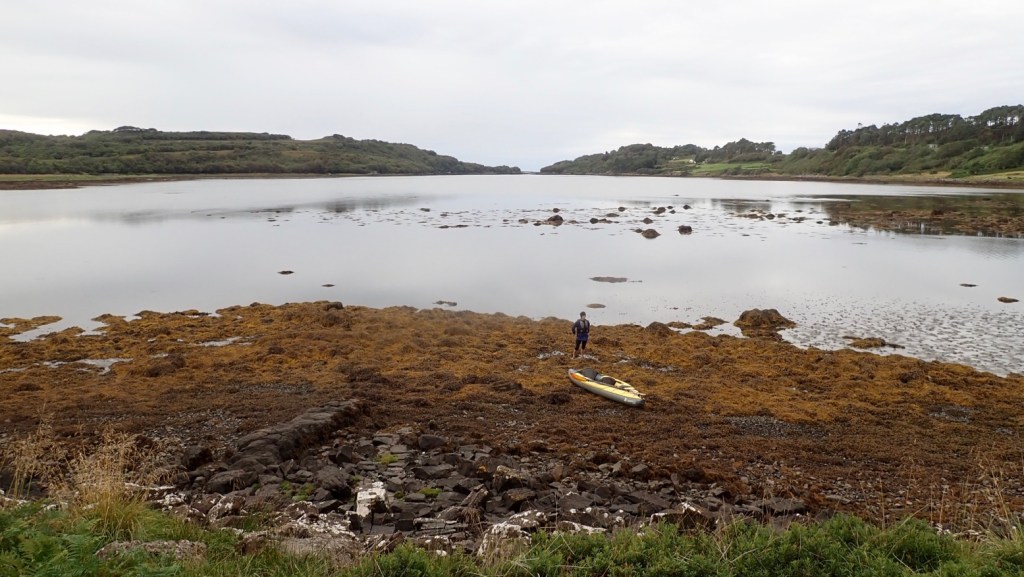
WTF sort of tide do you call this? (The Narrows are at the back)
That evening I rinsed and washed the boat, but with little chance of it drying off any day soon. The removable floor made the task easier and the muddy smudges on the yellow fabric lightened up with a bit of brushing. I couldn’t be bothered to check if the inner bladders were dry as there was little I could so about it.
Summary
The Moki II isn’t an IK I’d choose to own: too wide, too bulky and heavy, probably too slow solo, too bladdered and too pricey with the unneeded accessories. But it’s roomy, stiff, yellow and like any IK, is fun to paddle.




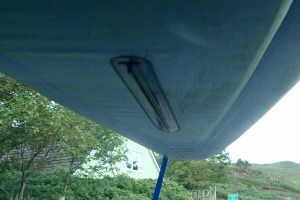

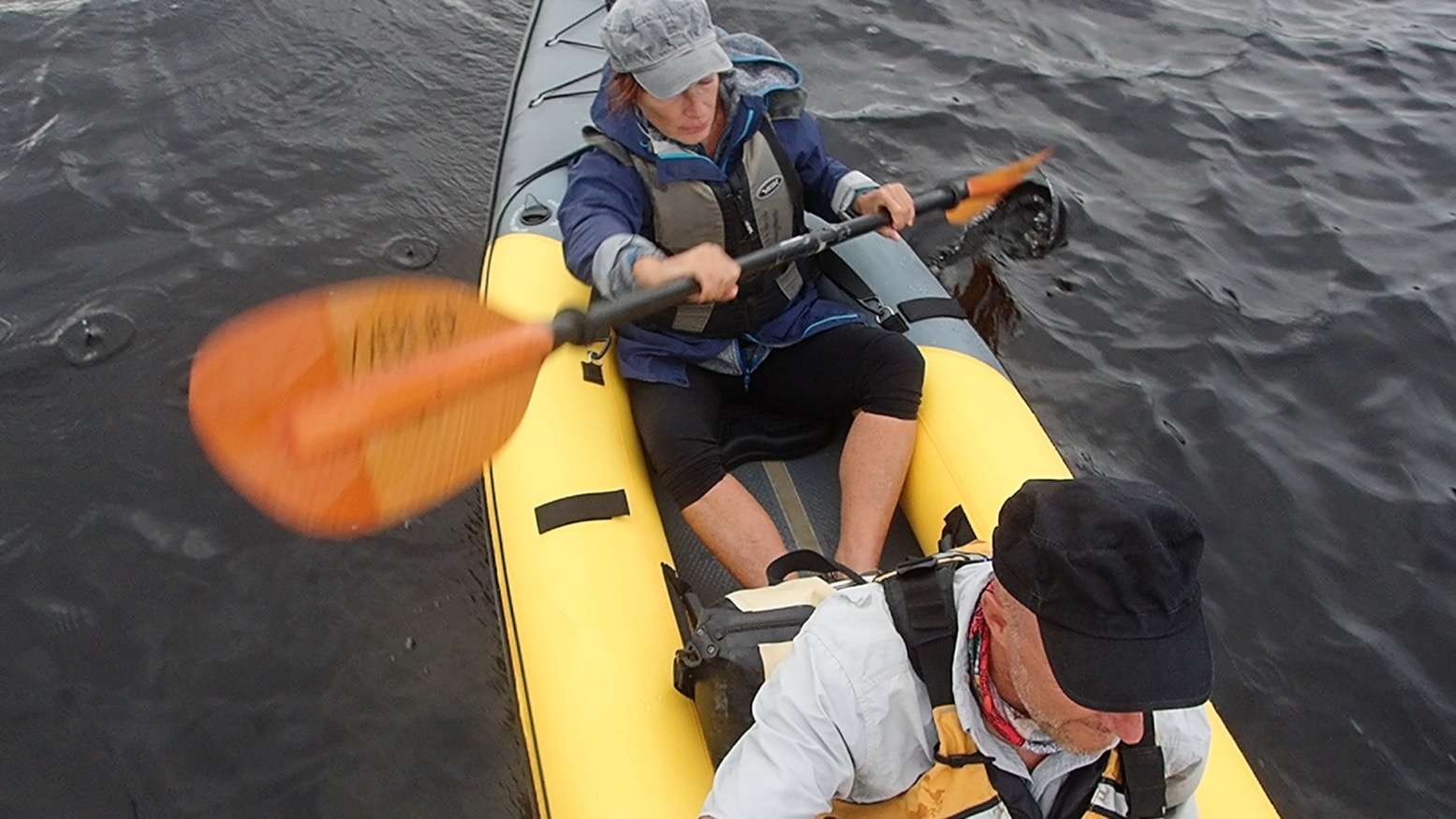




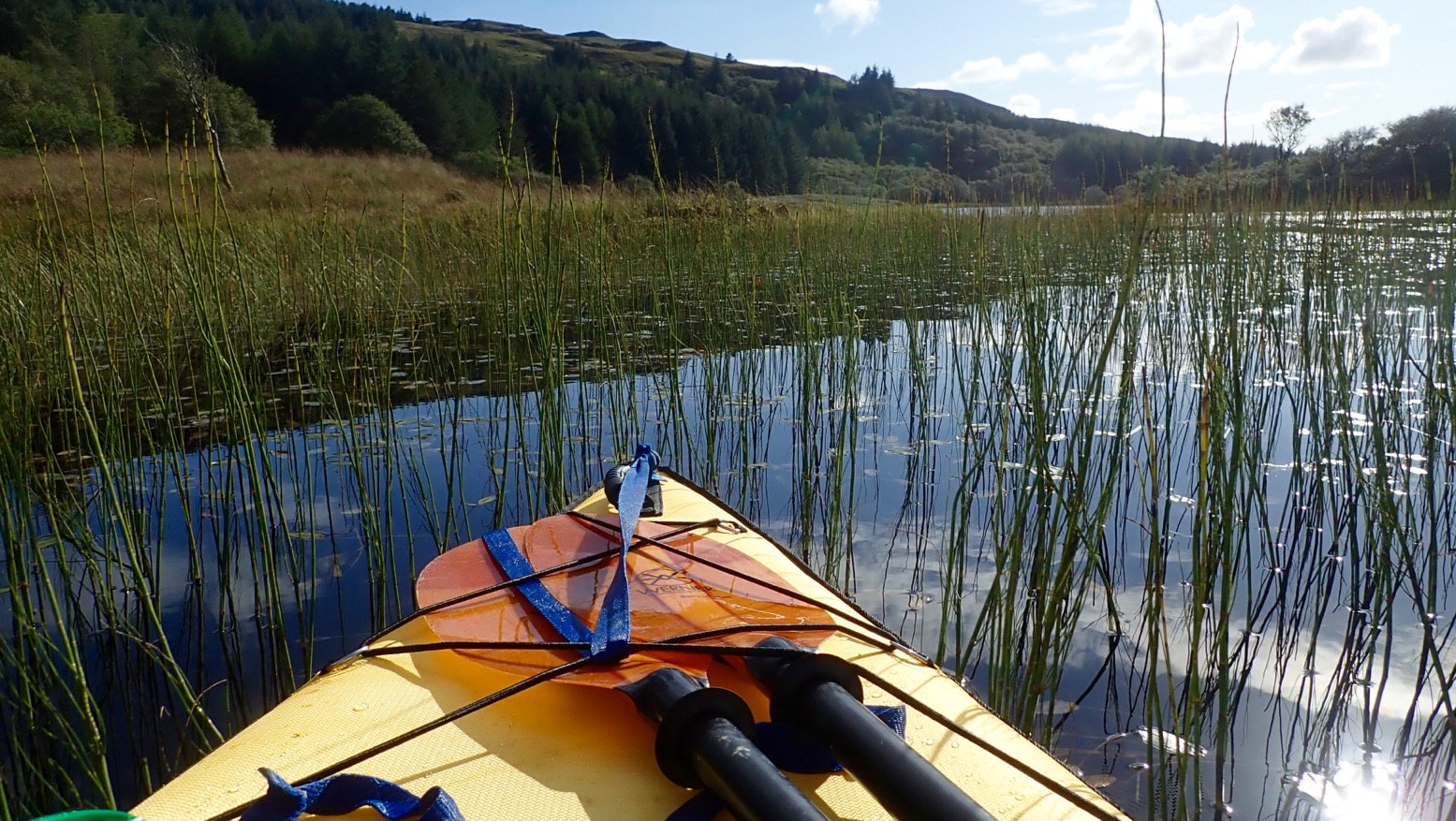

Hello,
I’m looking into purchasing a IK this year and am currently doing some research. Between the Moki 2 or the Aquaglide chelan which would you recommend for casual lake/flatwater paddling? Or if you have any other suggestions based on your experience? Appreciate the reviews and input!
thanks,
LikeLike
Hi Pat. I have not paddled a Chelan but I’d sooner get the Aquaglide 140 over the Moki II because it has no bladders so will be much easier to dry (this may not be important depending on where you live) and is more than adequate 35in (89 cm) in width.
LikeLike
Thanks Chris, alternatively my local IK dealer also offers the STAR Paragon in addition to the Moki and Chelan. Do you have an opinion on the STAR Paragon or the brand in general considering the three options I have? Thanks.
https://www.nrs.com/product/86247.02/star-paragon-inflatable-kayak
LikeLike
Hi Pat, Stars get made in Asia for NRS but unusually, like NRS’s expensive, Idaho-made Hypalon (rubber) IKs, Stars are tubeless which is a good thing, imo.
They used to make Stars self-bailing and with no footpegs but have now switched to normal ‘displacement hulls’ plus adjustable side pegs which are both big improvements. As with the new Chelans, until I was corrected I was pretty sure the DS floor was fixed in, but then looking at the first video on this page: https://www.nrs.com/learn/how-to-set-up-fold-star-paragon-pike, he mentions and shows lateral straps (like a new Chelan) that hold the removable floor in place. As with Chelan, it’s odd that NRS don’t mention or show this (not even in the manual) as if it’s either something to hide or not important. A removable floor makes cleaning and drying (and hull repairs) a whole lot easier and quicker.
Another thing that’s unclear is whether the bow and stern inserts are molded into the hull or removable pieces. They certainly look like they’ll make the boat slice through water well, but at a yard wide and < 12 feet long, the model you linked will not be so fast. The next-up XL is as wide but a foot and a half longer = faster. All these NRSs seem comparatively heavy: 40lbs for a 12-foot boat. And, like many PVC IKs, they may be bulky too for their size. Neither of these things may matter to you.
As with all these boats, if they let you try one before buying it, so much the better. I think in the US that's a whole lot easier than in the UK.
LikeLike